|
LONE PINE (CA) BRANCH
OF THE SOUTHERN PACIFIC RAILROAD UPDATE
Today I investigated the salvage
operations of the Lone Pine Branch of
the Southern Pacific Railroad to see what progress they had made
south of
Inyokern since my last visit on October 17. To my surprise, I
found that
the line has been left intact by salvage crews beginning at a
point six
miles south of Inyokern. While at it I also ventured south to
Searles
Station, the junction point with the Trona Railroad.
National Salvage Corporation, which
has contracted with Union Pacific
Railroad to salvage the line between Searles and a point south
of Lone
Pine, has apparently removed their equipment to the north end
of the line
since allowed to resume salvage operations by the Bureau of Land
Management, leaving the southern end intact.
I made an attempt to interview BLM
today, but arrived shortly after
closing time.
I quote a newspaper article published
in the Ridgecrest Daily
Independent, September 16, 1998.
DERAILING THE STEEL TRACKS OF LOCAL
HISTORY: FINAL CHAPTER FOR THE UNION
PACIFIC LINE?
by Sarah Palmer, Staff Writer
“Despite the efforts of some local citizens, it may be too
little
too late to save 81 miles of railroad tracks that snake from
Searles
Station to Bartlett just south of Lone Pine.
“Union Pacific, which owns the rails, is in the process
of
scrapping the historic track that once brought supplies and building
materials to the Indian Wells Valley to help build the beginnings
of
Inyokern, Ridgecrest and China Lake.
“‘It’s a completely economic decision,’ said
Mike Furtney, public
affairs manager for the railroad company. ‘There hasn’t
been a customer
for this track in over 15 years. I know there are people who
don’t want
to see this go, but when we filed for abandonment on this, they
had an
opportunity to comment and make their case.
“‘We put notices up locally that we were going to do
this.
Comment from the public never happened,’ Furtney said.
“Union Pacific began abandonment proceedings on the rails
in
1982, according to Laura Leigh Monterey, a local resident who
has been
trying to find a way to save the rails.
“In 1985, Lake Minerals of Cantil thought it needed the
rails to
help with its future expansion plans to help ship its product
out of the
area.
“Company officials began making minimal lease payments to
Southern Pacific, which owned the rails prior to merging with
Union
Pacific, to secure the track and stop its removal.
“But in January of this year, Union Pacific officials apparently
told Lake Minerals that unless they saw action on Lake Minerals
part when
the lease expired in June, they would begin removing the track,
Furtney
said.
“Monterey said refurbishing the rails could help bring economic
growth to the valley.
“Using a two-pronged approach -- tourism and commercial
business
-- it just might work to help the local economy, she said.
“‘There isn’t enough business for just one thrust
to be
successful,’ she said.
“The money for refurbishing could possibly come from a grant,
Monterey suggested. But to even begin to refurbish the rails,
the cost
would be prohibitive, Furtney said.
“‘It’s a fairly expensive procedure to refurbish
the track, and
it could easily range in the millions of dollars,’ he said.
‘The salvage
of the rails and ties alone is over $1 million.’
“Union Pacific contracted with an East Coast-based company,
National Salvage Corporation, to begin the salvaging process,
which began
in early August.
“However, the removal of the rails has been stopped on public
lands -- beginning at the bend in the road on old Highway 395
where it
begins to head towards Searles station -- controlled by the Bureau
of
Land Management.
“The BLM served Union Pacific with a cease and desist order
Aug.
27 to allow its officials time to study the environmental impact
of
removing the tracks, according to Peter Graves, real estate specialist
with the bureau.
“‘We have no jurisdiction over what happens on the
private
lands,’ Graves said. Union Pacific was tearing up track
by the reservoir
when the order was served, he added. Some of the rails already
taken up
in the northern section of the track had passed through public
land, but
only minimal amounts, according to Graves.
“The main concern for BLM officials, Graves said, is that
proper
environmental and archaeological studies be done to help mitigate
the
damage the removal might cause. Various government and private
entities
are seeking several different reports to ensure this is the case,
he
said.
“‘We’re setting the wheels in motion to take a
look at all of
this,’ Graves said, ‘and we are taking public comment
on the issue as
well. We don’t have enough information at this time to say
whether or
not the removal will continue.’
“Those who want to give input on the rail situation can
do so by
mailing in their comments to the BLM -- but they need to be postmarked
by
Friday, Graves said.
“It is unknown how long the BLM will take to make its decision,
Graves said, mainly because the time frame for the reports to
come in is
also unknown.
“‘We’re just beginning the process,’ he said.
“Comments about the rails can be mailed to the local BLM
office
at 300 S. Richmond Rd., Ridgecrest, 93555.”
________________________________________________________________________
Speaking with local historian and
president of the Historical Society of
the Upper Mojave Desert, Lou Pracchia, I found that the main
railroad
station building once located at Inyokern is located at a Ridgecrest
junkyard.
___________________________________________________________________
On Tuesday, December 1, 1998 I visited
the Ridgecrest office of Bureau of
Land Management (BLM) to find out information regarding the salvage
of
the Jawbone Branch of the Southern Pacific Railroad. I spoke
with Peter
Graves, project manager for the BLM, and the staff archaeologist,
whose
name I didn’t catch. Notes:
· BLM had a cease and desist order placed against salvage
of the line
from August 27, 1998 to November 23, 1998. The salvage company
is now
free to remove the remainder of the rails and ties. All but the
section
between Searles and the old US395 crossing north of Searles will
be
eliminated.
· Rails and ties are to be removed, but BLM office unsure
of whether
trestles will be included in the removal.
· Contract to remove rails & ties: National Salvage
& Service Company,
P.O. 300, Clear Creek, Indiana, 47426. Phone (812) 339-9000,
fax (812)
331-8235.
· The company was required by BLM to hire an archeological
consultant to
oversee that aspect of the removal. The salvage equipment is
required to
stay on the railroad bed, the company must not disturb any area
outside
of a 30-meter easement with the grade at center.
· BLM has identified several prehistoric sites along the
right of way of
the grade.
· The archaeologist is unsure of who will own right of
way after salvage
is complete.
· The BLM and the National Register of Historic Places
did a survey along
the line to determine if the railroad qualifies as a historic
site. It
did not. Nearly all buildings associated with the line are gone.
The
most historic aspect of the railroad was its early years, in
which the
railroad was instrumental in the construction of the Los Angeles
aqueduct. Since then, most of the original rails and ties have
been
replaced so that virtually nothing of historic value remains.
· The Navy Spur at China Lake will eventually be removed
by the Navy.
_____________________________________________________________
Wednesday, December 2, 1998
I found workmen at a point a mile
southwest of the junction of US395,
China Lake Boulevard and Brown Road (old US395). Driving to the
site, I
met up with a foreman driving a pickup. I found that the company
will be
leaving trestles and culverts in place on the grade.
A backhoe with a jackhammer attachment
on its boom was busy loosening
each joint on the rails in preparation to removal. Speaking with
the
operator, I found that each joiner plate attaching sections of
rail are
loosened by hand, his job was to give each section a thorough
shaking to
break them loose in preparation to the crew which was supposed
to come in
December 3 and begin taking the rail and placing it to the side
of the
grade. The operator of the backhoe was a resident of Missouri.
At Pearsonville, I checked on the
operation at the tie yard there. I
noted two vehicles I haven’t seen before, a medium duty
truck & chassis
with a hydraulic arm with grabber attachment and a brand new
Caterpillar
tractor with large back and small front wheels with rubber tracks.
There
were no visible attachments on the tractor of any kind.
Driving north, I found a crew working
just to the north of the site of
the former Louisiana-Pacific lumber mill (three miles north of
Pearsonville and abandoned about 1986), unbolting rail joiner
plates.
At a point about seven miles south
of Olancha, I spied two semi trucks
with boom attachments picking up ties just north of Merritt Cut.
One
semi also pulled a trailer made for holding ties. Driving along
the
grade I met up with the crew and sought permission to photograph
and
videotape their work. Each truck utilized an elevated backhoe-like
boom
with a seat and operating controls, a grabber claw on the end
of the
boom. The operator would pick up all ties in reach and place
them on the
back of the truck. Each time the operators would grab ties, he
would
pick them up and drop them several times to get them to line
up, each
grab would result in 6-10 ties. After he snatched all the ties
he could
reach, he would then climb down a ladder and drive the truck
forward.
The operators worked swiftly, the semi without the trailer filled
his
load in about 10 minutes, the truck with the trailer finished
in about
15. They would then both drive to the place where they were dumping,
about two miles north near the junction of Sage Flat Road and
US395.
Each driver would then off-load his own ties and stacked them
neatly
ready for shipment to Pearsonville. Both semi trucks were from
Minnesota.
______________________________________________________________
Friday, December 4, 1998
Driving to Ridgecrest from Big Pine,
I spied just south of the mothballed
Pittsburgh-Liberty glass plant the new Caterpillar tractor seen
Tuesday
at Pearsonville sitting on the grade. Ties were still strewn
along the
west side of the grade. A large vehicle was moving along the
grade about
half mile south, but I could not get a good view of what it was.
Ties are embedded at Cartago and
Olancha, rail is laying on the east side
of the grade.
About three miles south of Olancha,
I could see a large amount of dust
raising from a cut west of the highway. I could not get a view
of what
was going on, nor access the cut from the road.
About two miles further south one
of the tire removal trucks was
operating about a hundred yards south of the tie dump at Sage
Flat road
and US395.
On the south end of the line where
rails are still in place, I returned
to find that one mile of rail had been removed. Continuing south
on a
powerline road I spied and videotaped a piece of equipment and
six men on
foot pulling rails.
__________________
David A. Wright
Great Basin Research
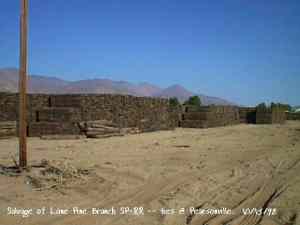
Tie yard at Pearsonville. October 15, 1998.
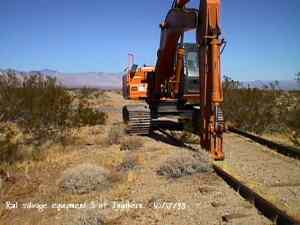
Removal equipment S of Inyokern, Oct. 17, 1998.
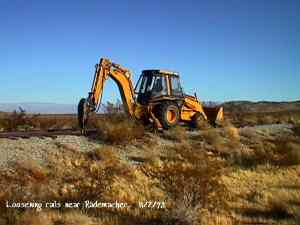
Backhoe w/jackhammer attachment loosening rails. December 2,
1998.
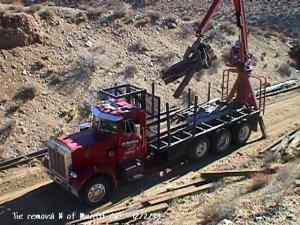
Removing ties near Olancha. December 2, 1998.
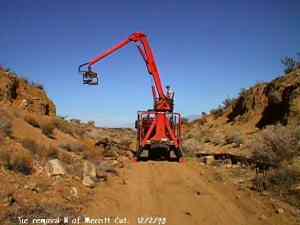
Removing ties near Olancha. December 2, 1998.
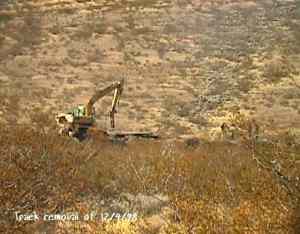
Removing rails S of Inyokern. December 4, 1998.
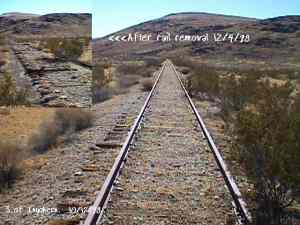
Before and after shots, October 17, 1998 and December 4, 1998
from same place S of Inyokern. |










